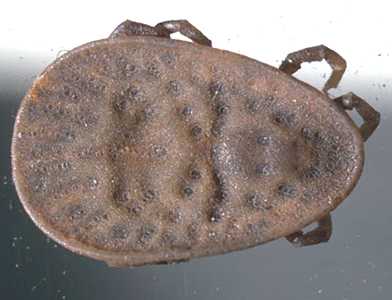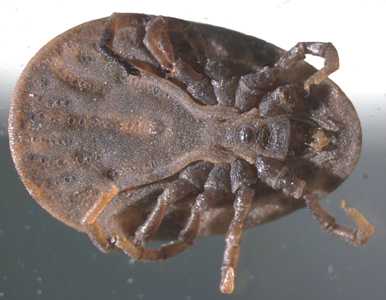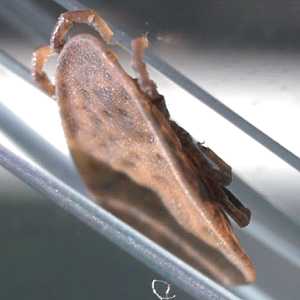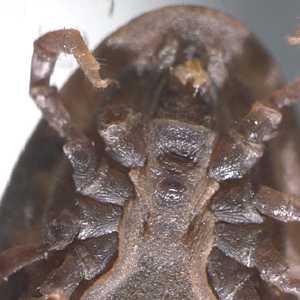
Case #304 - July, 2011
The DPDx Team received images from a hospital in the Netherlands for diagnostic assistance to identify an arthropod. The arthropods were presented to the hospital by a lady who found them under her mattress. She complained of being bitten during the night and wanted to know if the organisms of interest were responsible for the bites and if there was any public health importance associated with them. Figures A-C show dorsal, ventral and lateral shots of the arthropod, respectively. Figure D shows a close-up of the mouthparts. What is your identification? Based on what criteria? What, if any, is the public health importance of this organism?

Figure A

Figure B

Figure C

Figure D
Case Answer
This case represented incidental feeding by the pigeon tick, Argas reflexus. Diagnostic morphologic features included:
- the presence of eight legs, which ruled-out bed bugs, Cimex spp.
- the lack of a dorsal shield (Figure A) and mouthparts directed downward (Figures B and D), which ruled-out the hard ticks, Ixodidae.
- a clear demarcation between the dorsum and venter (Figure C).
After a diagnosis was made to the submitter in the original case, follow-up information was provided that the patient has pigeons roosting outside her bedroom window. Argas reflexus is generally not considered of being of public health importance to humans. There are documented cases where people have experienced anaphylactic shock after being bit by pigeon ticks, probably due to allergic reactions to salivary proteins. Members of the genus Ornithodoros are known vectors of Borrelia hermsi (tick-borne relapsing fever, or TBRF) in North America and several TBRF spirochetes in Africa.
This case and images were kindly provided by the Laboratory for Parasitology, Erasmus University Medical Center and Rotterdam Harbor Hospital, Rotterdam, the Netherlands.
Images presented in the monthly case studies are from specimens submitted for diagnosis or archiving. On rare occasions, clinical histories given may be partly fictitious.
DPDx is an education resource designed for health professionals and laboratory scientists. For an overview including prevention and control visit www.cdc.gov/parasites/.
- Page last reviewed: August 24, 2016
- Page last updated: August 24, 2016
- Content source:
- Global Health – Division of Parasitic Diseases and Malaria
- Notice: Linking to a non-federal site does not constitute an endorsement by HHS, CDC or any of its employees of the sponsors or the information and products presented on the site.
- Maintained By:


 ShareCompartir
ShareCompartir